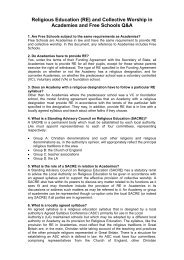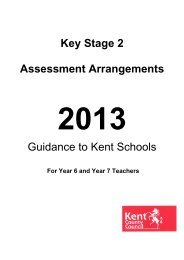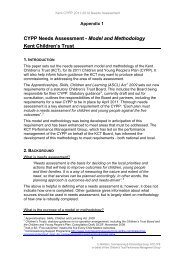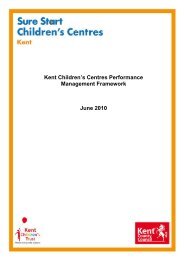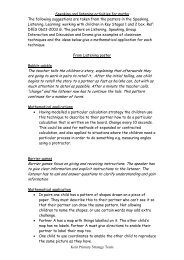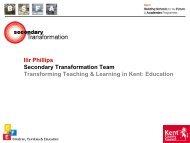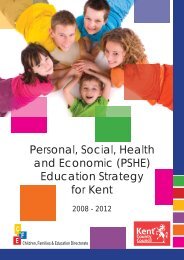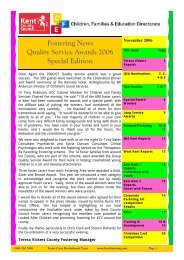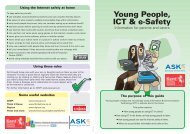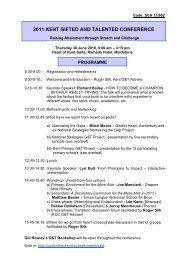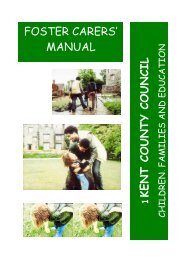Ofsted report - Kent Trust Web
Ofsted report - Kent Trust Web
Ofsted report - Kent Trust Web
You also want an ePaper? Increase the reach of your titles
YUMPU automatically turns print PDFs into web optimized ePapers that Google loves.
Report summary<br />
Improving outcomes for children and<br />
young people through partnership in<br />
Children’s <strong>Trust</strong>s<br />
A small-scale survey in six local authorities to evaluate the impact of Children’s<br />
<strong>Trust</strong>s arrangements on improving outcomes for children and young people<br />
The aim of this small-scale survey was to evaluate the impact of Children’s <strong>Trust</strong>s on<br />
improving the lives of children and young people, and particularly those whose<br />
circumstances make them potentially vulnerable. Inspectors visited six local<br />
authorities during the autumn of 2009 and spring of 2010 and held initial discussions<br />
with members of the Children’s <strong>Trust</strong>s in those areas. Common themes emerging<br />
from these discussions were identified. A further visit was made to each local<br />
authority between November 2009 and May 2010 to observe the work of front-line<br />
services that engaged directly with children and young people.<br />
The <strong>report</strong> draws together features common to each of the Children’s <strong>Trust</strong>s in<br />
relation to their leadership and management, systems and structures, and selfevaluation.<br />
It also evaluates the impact of provision commissioned by the Children’s<br />
<strong>Trust</strong>s’ strategic partners on improving the lives of potentially vulnerable children and<br />
young people in the six authorities. The purpose of this <strong>report</strong> is to publish the<br />
survey’s findings on the best practice found.<br />
The key features of the good practice identified in these six local authorities included<br />
a history of strong partnership working at a strategic level and highly effective<br />
leadership by directors of children’s services and lead members. Children and Young<br />
People’s Plans were clear, focused and designed to have an impact on outcomes.<br />
There was a determined commitment to early intervention and prevention, as well as<br />
evidence of services being redesigned around the needs of children and their<br />
families. There was also a range of integrated services in which professionals were<br />
clear about the benefits of joint working.<br />
Good relationships and effective cooperation existed between schools, the local<br />
authorities’ education and social care services, the police, health services and the<br />
voluntary sector. Inspectors found evidence of joint commissioning and planning,<br />
Improving outcomes for children and young people through partnership<br />
November 2010, No. 090234
especially in meeting the needs of children and families who were at risk of poorer<br />
outcomes, although joint funding was still at an early stage of development.<br />
Performance management was strong and there was a clear commitment to<br />
measuring impact on outcomes that went beyond using established performance<br />
indicators. Self-evaluation was robust. It resulted in clear improvement priorities and<br />
well-targeted action plans that delivered better outcomes for children and young<br />
people.<br />
In all the local authorities visited, the Children’s <strong>Trust</strong> had formalised the links<br />
between relevant partners. Considerable progress had been made in establishing<br />
terms of reference and arrangements for governance. Shared priorities informed the<br />
statements of action in the Children and Young People’s Plans in each of the local<br />
authorities.<br />
Leaders in these Children’s <strong>Trust</strong>s had established an effective framework for<br />
coordinating the work of partners. The good and outstanding leadership provided by<br />
local authority children’s services in particular was highly influential. In the six<br />
authorities visited, inspectors found senior officers of the Children’s <strong>Trust</strong>s to be<br />
pragmatic in seeking to accommodate differences in ways of working. Almost always,<br />
inspectors found representatives of partner organisations to be strongly committed<br />
to the principles of joint work. Nevertheless, the guidance informing the<br />
arrangements for Children’s <strong>Trust</strong>s, to which partners were working at the time of<br />
the survey visits, was vague about the expectations and accountabilities placed on<br />
partners. At strategic and operational levels, the success of joint working relied<br />
heavily on the skills and personal influence of the Chair of the Children’s <strong>Trust</strong> Board<br />
and, in particular, of the Director of Children’s Services.<br />
Self-evaluation was a strong focus in each of the Children’s <strong>Trust</strong>s visited. It was<br />
often difficult to disaggregate the impact of individual initiatives from numerous<br />
other influences. The most common measures used to assess impact were national<br />
indicators and individual case studies, although the Children’s <strong>Trust</strong>s were looking for<br />
other ways to measure impact on outcomes for children and young people. The<br />
redesign of services following review and evaluation of effectiveness was often a<br />
feature of the provision visited by inspectors. There is a link in each of the case<br />
studies in this <strong>report</strong> between the strategic work of the Children’s <strong>Trust</strong> and its<br />
effective practice with potentially vulnerable children or young people at the point at<br />
which provision is made for them.<br />
Key findings<br />
• In all six local authorities visited, the Children’s <strong>Trust</strong> provided the focal point for<br />
strategic work across the services that come into contact with children and young<br />
people. The Children’s <strong>Trust</strong>s strongly influenced arrangements for networking at<br />
all levels, evidenced by good cooperation, integrated services and joint<br />
commissioning and planning.<br />
• Status as a Children’s <strong>Trust</strong> formalised already well-established and effective<br />
partnerships and strengthened collective commitment and accountability. The<br />
<strong>Trust</strong>s visited had made considerable progress in developing policy, together with<br />
Improving outcomes for children and young people through partnership<br />
November 2010, No. 090234
the necessary systems and structures for implementation. Shared priorities and<br />
agreed joint activities informed the Children and Young People’s Plan and a<br />
strong emphasis on self-evaluation, performance management and the<br />
development of more effective ways of measuring impact on outcomes.<br />
• The proven good and outstanding capacity to improve services for children and<br />
young people in these local authorities was crucial in providing a firm foundation<br />
for ways of working in wider partnership. The leadership skills of the members of<br />
the Children’s <strong>Trust</strong> Boards were paramount in tackling a complex agenda, driving<br />
forward change and combining efforts to deliver better outcomes for children and<br />
young people.<br />
• The Children’s <strong>Trust</strong>s visited had been responsive to a range of government<br />
initiatives by developing ways of providing more integrated front-line services that<br />
were linked closely to and responded to local needs.<br />
• The Children’s <strong>Trust</strong> Boards, together with senior officers of partner agencies,<br />
showed considerable flexibility and willingness to find common ground from<br />
which to move services forward. They showed a strong commitment to early<br />
intervention and prevention. They worked effectively in a complex environment<br />
which involved different performance targets, priorities and ways of providing<br />
services.<br />
• The partners in the Children’s <strong>Trust</strong>s welcomed the greater clarity in statutory<br />
guidance about roles and responsibilities but did not think it was essential for<br />
developing good and outstanding partnership arrangements. All of them were<br />
strongly committed to joint working as the best means of improving outcomes for<br />
children and young people.<br />
• All the Children’s <strong>Trust</strong>s visited strongly recognised the need to measure the<br />
impact of actions taken to improve the lives of children and young people.<br />
National indicators and case studies were the two measures used most frequently<br />
to do this.<br />
Improving outcomes for children and young people through partnership<br />
November 2010, No. 090234
Main <strong>report</strong> published 1 November 2010<br />
www.ofsted.gov.uk/publications/090234<br />
The Office for Standards in Education, Children's Services and Skills (<strong>Ofsted</strong>) regulates and inspects to<br />
achieve excellence in the care of children and young people, and in education and skills for learners of<br />
all ages. It regulates and inspects childcare and children's social care, and inspects the Children and<br />
Family Court Advisory Support Service (Cafcass), schools, colleges, initial teacher training, work-based<br />
learning and skills training, adult and community learning, and education and training in prisons and<br />
other secure establishments. It assesses council children’s services, and inspects services for looked<br />
after children, safeguarding and child protection.<br />
If you would like a copy of this document in a different format, such as large print or Braille, please<br />
telephone 0300 123 1231, or email enquiries@ofsted.gov.uk.<br />
You may reuse this information (not including logos) free of charge in any format or medium, under<br />
the terms of the Open Government Licence. To view this licence, visit<br />
www.nationalarchives.gov.uk/doc/open-government-licence/, write to the Information Policy Team,<br />
The National Archives, Kew, London TW9 4DU, or email: psi@nationalarchives.gsi.gov.uk.<br />
This publication is available at: www.ofsted.gov.uk/publications/090234.<br />
To receive regular email alerts about new publications, including survey <strong>report</strong>s and school inspection<br />
<strong>report</strong>s, please visit our website and go to ‘Subscribe’.<br />
Royal Exchange Buildings<br />
St Ann’s Square<br />
Manchester<br />
M2 7LA<br />
T: 0300 123 1231<br />
Textphone: 0161 618 8524<br />
E: enquiries@ofsted.gov.uk<br />
W: www.ofsted.gov.uk<br />
No. 090234<br />
© Crown copyright 2010



